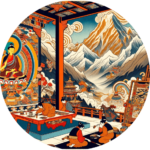4. Arts (བཟོ་རིག་པ་)

Seeing forms of enlightened body, speech and mind creates powerful imprints in our mindstreams and allows others, who otherwise aren’t inclined towards textual study, a gateway into the dharma. Making images and forms representing the qualities of awakening is said to accumulate vast amounts of merit which are sure to bear fruit in this and future lifetimes. The artist is also expected to perform their creation with undivided mindfulness and following the correct motivation. Some of these art forms include sculpture, architecture, painting, music, dance, the making of mandalas and tormas, etc. Differing from the modern Western art traditions in which usually the artist strives to find his or her own individual expression, Buddhist art generally follows rules of proportions and aesthetics which are in and of themselves pregnant with symbology and layers of increasingly subtle meanings. From the posture of the Buddha deities to the colors and the implements they hold, everything conveys a message, whether consciously or subconsciously. This is especially true from the Vajrayana perspective. Since art is such a somatic activity, it is difficult to learn solely through an online medium without using our hands and without being in the presence of a teacher. Anyhow, here are a few introductory resources.
Thangka Karma Gardri
A selection of online courses following the Karma Gardri Tradition of thangka art.
Himalayan Art Resources
An amazing resource for everything related to Himalayan Buddhist art.
